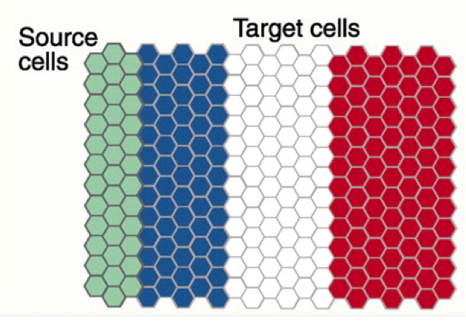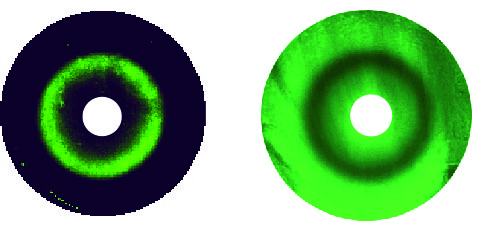 NEWS
NEWS
A new study on how to engineer synthetic gene networks, recreates the stripe patterns found in animals, using bacteria.
- Researchers at the CRG try to understand how networks of genes work together to create specific patterns like stripes.
- They have gone beyond studying individual networks and have created computational and synthetic mechanisms for a whole "design space" of networks in the bacteria Escherichia coli.
- The system proves to be more efficient and powerful than building networks one-by-one, and its results have been published in the journal Nature Communications.
Pattern formation is essential in the development of animals and plants. The central problem in pattern formation is how can genetic information be translated in a reliable manner to give specific spatial patterns of cellular differentiation.
The French-flag model of stripe formation is a classic paradigm in developmental biology. Cell differentiation, represented by the different colours of the French flag, is caused by a gradient of a signalling molecule (morphogen); i.e. at high, middle or low concentrations of the morphogen a “blue”, “white” or “red” gene stripe is activated, respectively. How cellular gene regulatory networks (GRNs) respond to the morphogen, in a concentration-dependent manner, is a pivotal question in developmental biology. Synthetic biology is a promising new tool to study the function and properties of gene regulatory networks (GRNs) by building them from first principles. This study developed synthetic biology methods to build some of the fundamental mechanisms behind stripe formation.

Fig.1 - The French Flag model of stripe formation: source cells secrete a signal. Receiver cells 'read' the signal concentration and make red, white or blue stripes by expressing genes.
In previous studies, gene circuits with predefined behaviors have been successfully built and modeled, but mostly on a case-by-case basis. In this study published in Nature Communications, researchers from the EMBL/CRG Systems Biology Research Unit at the CRG, went beyond individual networks and explored both computational and synthetic mechanisms for a complete set of 3-node stripe-forming networks in Escherichia coli. The approach combined experimental synthetic biology led by Mark Isalan, now Reader in Gene Network Engineering at the Department of Life Sciences of Imperial College London with computational modelling led by James Sharpe, ICREA Research Professor and head of the Multicellular Systems Biology lab at the CRG.
"We have performed a very innovative and ambitious study: we applied a three-step approach for the effective exploration and creation of successful synthetic gene circuits. We created a theoretical framework to study the GRNs exhaustively” - 100,000 versions of over 2800 networks were simulated on the computer. We then successfully developed a synthetic network engineering system and, finally, we confirmed all the new experimental data by fitting it to a single mathematical model" explains the corresponding author James Sharpe.
First, Andreea Munteanu, co-author of the study, performed a theoretical screen for finding all design classes that produce the desired behaviour (stripe formation in a morphogen gradient). During this step she discovered four fundamentally-different mechanisms for forming a stripe. Next, Yolanda Schaerli, first author of the study, successfully demonstrated that the four networks are functional by building them in the bacteria E. coli using the tools of synthetic biology. The third step was to verify the distinct mechanisms by fitting all the experimental data to a mathematical model.
The success of this procedure allowed the researchers to go one step further to find a deeper design principle of stripe formation. They identified a simpler 2-node network – where the stripe gene is directly controlled by both activation and repression from the morphogen sensor gene– that replicates the stripe-forming ability in its simplest form. They were successful in building this archetype of stripe forming networks and ultimately discovered that it can even display an “anti-stripe” phenotype (fig. 2).
"Combining exhaustive computational modeling with synthetic biology is more efficient and powerful than building networks one-by-one" says the corresponding author Mark Isalan. "Our approach provides a new and efficient recipe for synthetic biology - a new scientific discipline which aims to engineer all kinds of useful biological systems"

Fig 2 - Bacterial lawns display green fluorescent ring (“circular stripe”, left) as a function of a chemical gradients from central paper disks (white) or an anti-ring (“circular anti-stripe”, right).
The study was funded by the following agencies: Swiss National Science Foundation (SNSF) Fellowship, Marie Skłodowska-Curie Action (MSCA), Ministry of Economy and Competitiveness (MINECO) through the program "Severo Ochoa Centres of Excellence", Fundació Marató de TV3, Institut Catalan de Recerca i Estudis Avancats (ICREA), European Research Council (ERC), and the MINECO-EMBL agreement.
Reference:
Schaerli, Y., et al. A unified design space of synthetic stripe-forming networks. Nature Communications, 5:4905. DOI: 10.1038/ncomms5905
For more Information: Laia Cendrós, Press Officer at the CRG, laia.cendros@crg.eu
Mark Isalan is available for Skype and/or Telephone conferences. James Sharpe is based at the CRG, Barcelona, and is able to meet via Skype/telephone. Please contact Laia Cendrós to set an appointment
Notes:
1- the study experiments were performed at the CRG prior the departure of the coordinator of the study, Mark Isalan, now Reader in Gene Network Engineering at the Department of Life Sciences of Imperial College London.
2- Images of the video are licensed under a Creative Commons Attribution- NonCommercial-ShareAlike 4.0 International License, the Creative Commons Attribution-Share Alike 3.0 Unported license.

